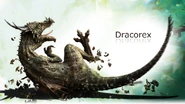| "Dracorex" Temporal range: Late Cretaceous | |
|---|---|

| |
| Scientific classification | |
| Kingdom: | Animalia |
| Phylum: | Chordata |
| clade: | Dinosauria |
| Order: | †Ornithischia |
| Family: | †Pachycephalosauridae |
| Tribe: | †Pachycephalosaurini |
| Genus: | †"Dracorex" |
| Species: | "D. hogwartsia" |
| Binomial name | |
| "Dracorex hogwartsia" Gilmore, 1931 | |
"Dracorex" is a highly dubious genus of pachycephalosaur from the Late Cretaceous Period. Its name essentially means Dragon King, and its type species was Dracorex hogswartia.[1][2][3] Recently, the genus has been synonymized with Pachycephalosaurus as an early growth stage.
Description and Naming[]

A Dracorex eating. Credit: WM
Dracorex is a pachycephalosaur from the end of the Cretaceous Period which was identified after the discovery of a spectacular skull. The skull lacks the dome characteristic of this group and instead has spikes and frills reminiscent of the mythical dragons.
After studying the skull, scientists named the species Dracorex hogwartsia, the 'dragon king of Hogwarts', after the fictional Hogwarts School in the Harry Potter books by JK Rowling.[4]
The skull is covered in spikes and horns, and much flatter than other thickheaded dinosaurs. Scientists haven’t seen a fossilized skull quite like this one before, so they put it on display for museum visitors to help name it. The spiky creature reminds people of dragons from fantasy books and movies, especially the Harry Potter series. So scientists named the dinosaur Dracorex hogwartsia, which means “dragon king of Hogwarts,” after the magical school.
History and Invalidity[]
It is known from one nearly complete skull (the holotype TCMI 2004.17.1), as well as four cervical vertebrae: the atlas, third, eighth and ninth. These were discovered in the Hell Creek Formation in South Dakota by three amateur paleontologists from Sioux City, in the U.S. state of Iowa. The skull was subsequently donated to the Children's Museum of Indianapolis for study in 2004, and was formally described by Bob Bakker and Robert Sullivan in 2006.[5]
However, Jack Horner et al. suspect that it is a juvenile Pachycephalosaurus and an analysis of pachycephalosaur fossils by a joint team from the University of California, Berkeley and the Museum of the Rockies has questioned the validity of two named genera of pachycephalosaur, Dracorex and Stygimoloch. According to the team, specimens of Dracorex and Stygimoloch might actually represent earlier growth stages of Pachycephalosaurus. This has been supported in a 2016 analysis of the youngest Pachycephalosaurus material known, which indicates that the unique features of Dracorex represent instead ontogenetically variant features on a Pachycephalosaurus growth curve.[6]
As of currently, this genus and potentially Stygimoloch are considered synonyms of the senior genus Pachycephalosaurus as younger specimens; Stygimoloch is debated to have been a separate species in said genus.
In the Media[]
- Dracorex appeared Dino Dan.
- Dracorex appeared in Everything From Now On.
- Dracorex made an appearance in both the Jurassic World Alive and Jurassic World Evolution 2 as collectible dinosaurs.
- Dracorex starred in an episode of Primeval as an antagonist.
Gallery[]
- ↑ https://dinosaurpictures.org/Dracorex-pictures
- ↑ https://gagebeasleyprehistoric.com/profiles/dracorex/
- ↑ https://prehistoricbeastoftheweek.blogspot.com/2013/09/dracorex-prehistoric-animal-of-week.html
- ↑ https://evrimagaci.org/dinozorlar-icerisindeki-ejderha-dracorex-hogwartsia-3501
- ↑ https://encyclopedia.pub/entry/32398
- ↑ https://encyclopedia.pub/entry/32398





